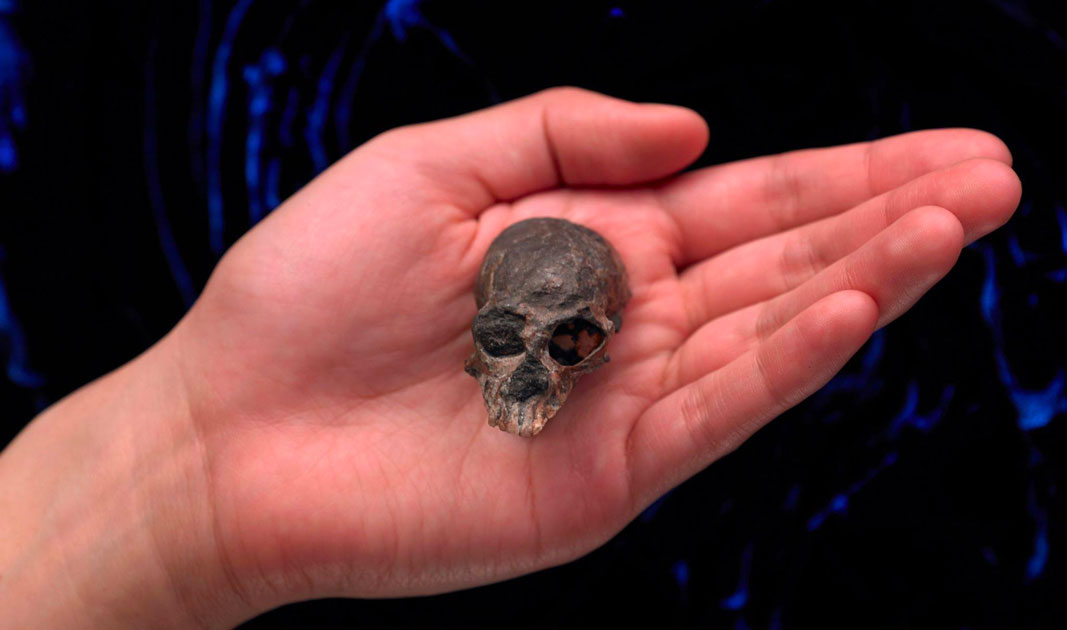20-Million-Year-Old Skull Whispers Evolutionary Secrets
A visually entrapping 20-million-year-old skull is providing new data on the evolution of brains in primates. Imagine looking through a wormhole into the past and seeing your ancient origins up close, well, if you did so, you might be looking at this incredible 20-million-year old skull.
On his epic 1832 voyage, Charles Darwin explored the mouth of the canyon where Chilecebus carrascoensis would eventually be discovered 160 years later, high in the Andes Mountains of Chile in South America. Winter snows forbade Darwin from entering the cordillera but this rare fossil was found only a few kilometers east of where Darwin stood.
- Scientists from Atapuerca Revolutionizing Human Evolution
- Moving on from a Darwinian World View
- Scientists Discover Evolutionary Leap 500 Million Years Ago

The voyage of the Charles Darwin. (Sémhur / CC BY-SA 4.0)
Examining The Ancient Skull For ‘Brain Data’
Anthropoid primates, like this example, have always been believed to have had similar brain sizes as modern monkeys and that they slowly increased over time, but according to a new paper published in the journal Science Advances, on one of the oldest fossil primate skulls from the species known as Chilecebus carrascoensis, “this enlargement process happened repeatedly and independently with occasional decreases in size”.

Brown spider monkey is a descendant of the Chilecebus carrascoensis. (Fir0002 / CC BY-SA 3.0)
Co-author André Wyss from the University of California Santa Barbara said “This exquisite fossil, found just a few kilometers east of where Darwin stood, would have thrilled him,” but more so the new results, for ‘all’ previous research on this ancient species had only provided generalized data of the animal’s brain size relative to its body size, a measurement known as the ‘encephalisation quotient’ (EQ), but lead author Xijun Ni, a research associate at American Museum of Natural History, said in the paper that humans have “exceptionally enlarged brains, but we know very little about how far back this key trait started to develop”.
3D Modeling a 20-Million-Year-Old Skull
John Flynn is Frick Curator of Fossil Mammals in the Division of Paleontology at the American Museum of Natural History, and as author of more than 100 scientific publications his research focuses on the “evolution of mammals and Mesozoic vertebrates, geological dating, plate tectonics, and biogeography”. Flynn told reporters “Chilecebus is one of those rare and truly spectacular fossils, revealing new insights and surprising conclusions every time new analytical methods are applied to studying it”.
High EQ signifies larger brains, which are found most often in primates more so than in other mammals, but humans have even higher EQs than most others. According to a report in Science Daily the phylogenetic encephalisation quotient (PEQ), “corrected for the effects of close evolutionary relationships, for Chilecebus is relatively small, at 0.79” while most monkeys have PEQs ranging from “0.86 to 3.39, with humans coming in at 13.46”.
What this all means is that the team of researchers found cerebral enlargement occurred “repeatedly and independently in anthropoid evolution, with occasional decreases in size” and for the first time, researchers applied high-resolution X-ray computed tomography (CT) scanning and they created digital 3D reconstructions to analyze the “fossilized cranial cavity of Chilecebus”.
New Views On Anthropoid History
These new results reveal an intricate brain structure with what the scientists called ‘unexpected proportions’ which suggested the internal structure of primate brains probably grew proportionately larger as brain size evolved. The scientists also measured the skull’s eye sockets and the entrance to the optic canals in which the optic nerves would have been located, and the olfactory bulb which controls smelling functions and while the olfactory bulb was proportionately small, “suggesting poor sense of smell,” the researchers found the decreased smell was “not offset with an enhanced visual system, as seen in primates today”.

Scientists are studying the skull’s eye sockets and the entrance to the optic canals. (Science News / YouTube)
According to the authors, in conclusion, these new results prove that visual and olfactory systems were “decoupled during anthropoid brain evolution which was far more checkered” than previously thought, and that the brain enlarged repeatedly and independently over the course of anthropoid history.
Top image: 20-million-year-old skull discovered in the Andes Mountains of Chile. Source: AMNH / Facebook .
By Ashley Cowie



















